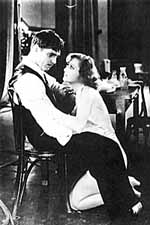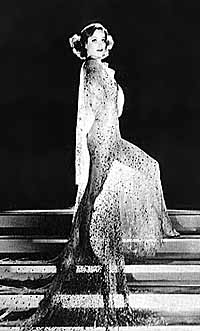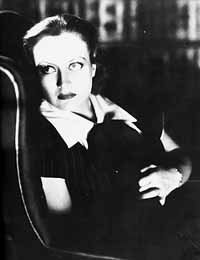Working at MGM assured that her persona wouldn't take the same tract as Bette Davis at Warners or Barbara Stanwyck at Columbia (and Warners). With the typical MGM preoccupation with delivering glamorous goods for the depression era audience, Crawford starred in several movies where she dallied with the privileged classes, with politicians and millionaires.
Unlike Davis and Stanwyck who would frequently hitch up with working class men, Crawford toiled exclusively for men with power and money. She was available, but only for the rich. In Possessed (1931) she even point blank asks men "Are you rich?" until she finds a Park Avenue lawyer played by Clark Gable: "I'm what's known as a very rich man." Joan says (with not a hint of sarcasm.), "That's nice. I couldn't waste my time with you if you weren't."
The common thread between her movies was the lower-class origin of her characters. These were women from working class families who strove for a better life by finding men with power and prestige. The movies carefully give her motives for her actions, showing her desperate conditions. In Dancing Lady, she gets arrested during a police raid of a burlesque revue. A judge asks "Why were you doing a striptease?" And Joan says, "If you'd walked the street looking for a job and hadn't eaten for a week you'd do a striptease too."
MGM supplied the movie star magazines with reams of material about Joan's background, from her birth as Lucille Le Seur in San Antonio, Texas to her travails as a clerk at a department store in Kansas City, Missouri. As a result her fans knew all about her rise from the notions counter to the heights of stardom. To her fans, her personnel life and her screen persona became so intermingled that they were indistinguishable.
Her movies thrived off of her background, building characters who faced indignities and embarrassments all too similar to those faced everyday by her fans. In Possessed, for example, she becomes a kept woman for a rising politician (Gable) who doesn't believe in marriage after he was burned once by an adulterous wife. Joan quickly learns how to talk to servants, how to order food and the correct serving temperatures for Chablis and burgundy. When she holds a dinner party for Gable, his business crony shows up with a cheap floozy. "You've got your sweetie here. Why shouldn't I have mine? What's the difference between ‘em." Joan wilts only slightly, showing a stiff upper lip, but we see the devastation in her eyes.
 Like few of her contemporaries, Joan balanced the common and the cultured. When she played a factory girl or a maid, she brought a distinctly regal aire to the role, such as in Sadie McKee where a rich man mistakes her as an "aristocrat," only to find out she is a servant girl. And when she played high society dames, she brought a healthy dose of street-wise common sense to her Park Avenue flats and glitzy designer duds. When she strayed too far from home, as in Rain, she fell flat, for the character of Sadie Thompson was beyond her experience. But when the roles were right, she acted with an earnestness and dedication that made her inseparable from the characters that she played. (This same earnestness also made her unable to play comedy.)
Like few of her contemporaries, Joan balanced the common and the cultured. When she played a factory girl or a maid, she brought a distinctly regal aire to the role, such as in Sadie McKee where a rich man mistakes her as an "aristocrat," only to find out she is a servant girl. And when she played high society dames, she brought a healthy dose of street-wise common sense to her Park Avenue flats and glitzy designer duds. When she strayed too far from home, as in Rain, she fell flat, for the character of Sadie Thompson was beyond her experience. But when the roles were right, she acted with an earnestness and dedication that made her inseparable from the characters that she played. (This same earnestness also made her unable to play comedy.)
These are the movies that made Joan Crawford into a star. She would play off of this persona for the rest of her career, but only by reinventing new twists on her persona after the public taste changed. In the forties, she became the matriarchal, self-sacrificing business woman and in the fifties, she became the love-starved, middle-aged woman with questionable taste in men.
The early thirties are a key period in her development as a star. Denied the big star showcases and plum roles that Norma Shearer and Greta Garbo received at MGM, she played in the sometimes silly (and often delightfully entertaining) star vehicles crafted especially for her talents. As she said, "I was Metro's creation. They gave me a name and a career and a lifestyle."











 Like few of her contemporaries, Joan balanced the common and the cultured. When she played a factory girl or a maid, she brought a distinctly regal aire to the role, such as in Sadie McKee where a rich man mistakes her as an "aristocrat," only to find out she is a servant girl. And when she played high society dames, she brought a healthy dose of street-wise common sense to her Park Avenue flats and glitzy designer duds. When she strayed too far from home, as in Rain, she fell flat, for the character of Sadie Thompson was beyond her experience. But when the roles were right, she acted with an earnestness and dedication that made her inseparable from the characters that she played. (This same earnestness also made her unable to play comedy.)
Like few of her contemporaries, Joan balanced the common and the cultured. When she played a factory girl or a maid, she brought a distinctly regal aire to the role, such as in Sadie McKee where a rich man mistakes her as an "aristocrat," only to find out she is a servant girl. And when she played high society dames, she brought a healthy dose of street-wise common sense to her Park Avenue flats and glitzy designer duds. When she strayed too far from home, as in Rain, she fell flat, for the character of Sadie Thompson was beyond her experience. But when the roles were right, she acted with an earnestness and dedication that made her inseparable from the characters that she played. (This same earnestness also made her unable to play comedy.)

 James Cagney
James Cagney Barbara Stanwyck
Barbara Stanwyck




